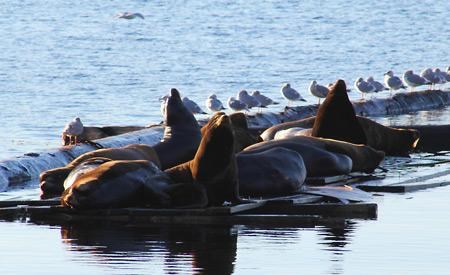VIDEO – Depending on one’s opinion, Townsite residents and visitors have been either treated to or tortured by an influx of barking sea lions on the breakwater lately.
The sound on some days resonates up the hill and throughout Townsite, often starting early morning and not letting up until the sun goes down. The mammals are a draw for some people, who have been going to the shore to take photos and observe the creatures. Complaints about the incessant barking and rude wake-up calls have been coming from other residents wondering what all the noise is about.
Nature photographer, writer and creator of the website Whales and Dolphins of BC, Susan MacKay believes that even though it may seem like there are more sea lions this year, there may actually be fewer. She said the areas she’s used to seeing the loud creatures in are noticeably vacant. Weather, predators and food sources have driven the sea lions away from their favourite spots and breakwaters around Powell River have become a more suitable gathering place.
Transient orcas in the Strait of Georgia may be one factor, according to MacKay. The orcas, which travel in smaller, less familial groups than resident orcas, feed primarily on marine mammals, including sea lions. MacKay said the whales have been spending time around Powell River and she knows they have been feeding on sea lions, perhaps driving them closer to shore than normal.
“Some of [the barking] may be announcing that okay, finally they’re gone,” said MacKay. “They make a big announcement and everybody barks at one another and now they can get back to vying for position on the rocks.” The higher up the breakwater a sea lion gets, the more protected he is, making it in the animal’s favour to establish dominance and become king of the hill.
Weather is another factor, according to MacKay, with stormy seas and high water marks forcing the sea lions to abandon usual areas and seek higher ground. Typical habitats for the mammals, such as Rebecca Rock, Vivian Island and Mitlenatch Island, are noticeably bare for this time of year, possibly owing to their more exposed locations.
The sea lions making all the noise are male California sea lions (Zalophus californianus), according to Fisheries and Oceans Canada research biologist Peter OIesiuk. In the winter months, after breeding, the males go north to eat, gain mass and vie for position in the social hierarchy. Often California sea lions will mingle with Steller’s sea lions (Eumetopias jubatus) during this time, as seems to be the case with the Townsite group.
Olesiuk puts less stock into transient orcas as a cause for the gathering and instead attributes it to the availability of food. Sea lions typically go where the food is, said Olesiuk. “Their distribution is dictated by where they can find prey. They’re just on the move constantly and they’ve got traditional areas that they check out...until they stumble upon one where there’s something going on.”
California sea lions are known for their barks, grunts and roars and Townsite residents, whether they want to or not, are becoming amateur experts on the animal’s vocal range.



